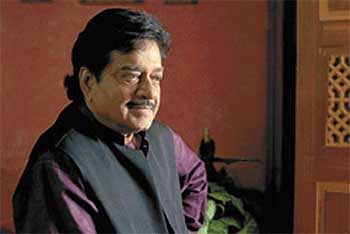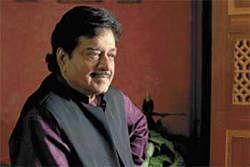
A stylish blend of pith and humour, Sinha, who’s successfully acted and sung in films has also produced movies, written columns, hosted and judged television shows, and also towered in politics.
Beginning with the role of a havaldar in the 1969 Sajan, he was noticed in his Pakistani soldier cameo in Prem Pujari and as the slimy debauch of Khilona (1970). The claps began with Chetna (1971), and by the release of Mere Apne later that year, he began to be cheered at his entry on screen, applauded when he beat up the hero and became the first villain to have fans among college girls and songs filmed on him! Raampur Ka Lakshman, Bhai Ho To Aisa, Babnl Ki Galiyan and Blackmail saw him peak as the bad guy.
But Mr Confidence impressed filmmakers enough to simultaneously cast him in positive roles (Aa Gale Lag Jaa, Dost) and so the transition to a hero was not too difficult, initially with gray roles in modest films (Kundan, Gaai Aur Gori) and finally in blockbusters like Kalicharan and Vishwanath.
How does he view the four decades that have passed? “I am blessed enough to realise this only when you mention it! People say that I look the same as when I first came in, and that my persona and voice still have the same fire. I have always believed in growing as an actor and as an individual. I did face opposition in both capacities, but I would rather dwell on those who helped me or contributed to my growth.”
And the Shotgun (as he is known) begins firing. “Mohan Segal and Dev Anand gave me a break when I came to Mumbai from the Film & Television Institute in Pune. Mumtaz recommended me for L V Prasad’s Khilona and many other films. Chetna was planned with Rehana Sultan and me, but I suggested Anil Dhawan’s name as he had the innocence needed for the role, but I got a 10-minute cameo that made a huge difference to my branding. Character artistes Jeevan and Kanhaiyalal helped me refine my art further.”
Sinha also credits the filmmakers and distributors who saw his escalating popularity and helped him turn hero. “As a villain, I had a 25-foot cutout for Babul Ki Galiyan, and hero Sanjay Khan did not!” he recalls. “And in his very next film, S D Narang cast me as a hero opposite the same heroine, Hema Malini. Things like this kept happening. I even got some of the best songs, like ‘Pukaro mujhe tum pukaro’ (Buniyaad) and ‘Mujhko mere baad zamana dhoondeg’ (Ek Nari Do Roop).”
Sinha rates Dulal Guha, Hrishikesh Mukherjee, Raj Khosla and Vijay Anand high among filmmakers who helped him evolve, and Manmohan Desai for giving him diverse roles. Citing Mumtaz, Dharmendra and Jeetendra as the co-stars he was most comfortable with, he reveals that the late Meena Kumari was “very proud of me for my unique grammar and dialogue delivery,” Hema Malini declared him as her favourite co-star and Salim Khan of Salim-Javed stood like a rock by him through tough times.
Sinha admires today’s stars, calling them “well-behaved and professional,” and crediting Salman Khan and Akshay Kumar for making the country fitness-conscious. Although he respects the actors and filmmakers of today, he feels that they are trapped by the ‘corporate’ producers whose films lack soul. “Off late, there have been many bitter jolts for the corporate setups and I hope this improves cinema,” he says.
Considering good upbringing as vital as training, Sinha is proud of his children — Luv, Kush (trained in filmmaking and now assisting Sanjay Bhansali) and Sonakshi for trying to make it on their own. “Hits and flops are a part of everyone’s career, so I am not upset about Sadiyaan. Luv was appreciated and Raj Kanwar never knew that he was my son when he spotted him,” he says proudly. “Sonakshi is now doing Salman Khan’s home production Dabanng.”
Sinha’s prime motivation for joining politics was doing something meaningful for the people who have made him who he is. “I joined the Bharatiya Janata Party when it had two seats in the Parliament, so it was never to earn fame. Joining the opposition teaches you about struggles, values and commitment. My inspirations were Jayaprakash Narayan and Nanaji Deshmukh, who taught me clean politics.”
Sinha now essays real-life politician N T Rama Rao in Ram Gopal Varma’s Rakta Charitra. “The role was great enough for me to shave off my moustache for the first time ever. Today, the roles I do must match my age and image, and should not hurt national interest. And Varma had paid me a compliment by saying that he cannot conceive a film now without me in it!”
